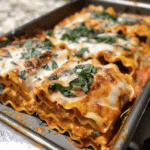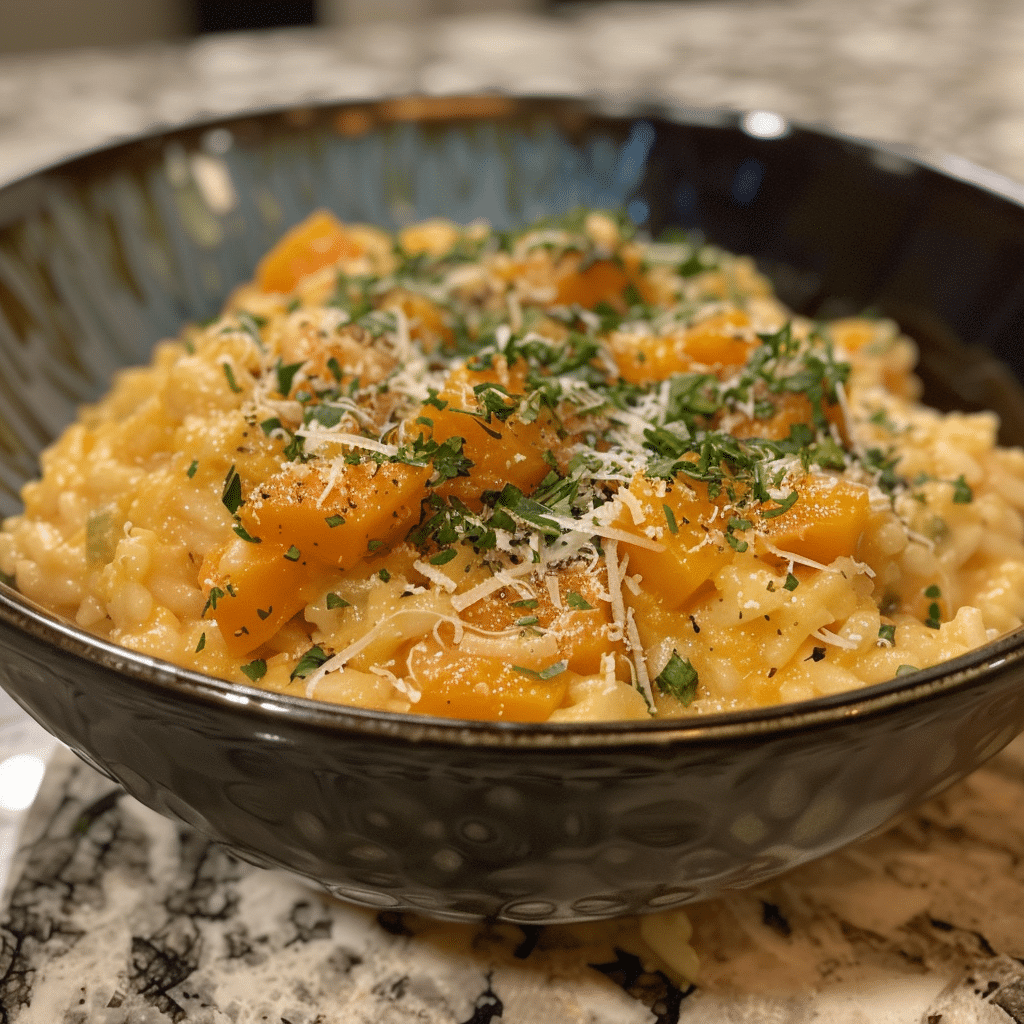Why You’ll Love This Recipe
There’s something deeply comforting about risotto with the warm sweetness of butternut squash mingling with savory cheese, herbs, and a hint of wine. This dish is rich without being heavy, perfect for cozy dinners or sharing with friends and family. It hits that sweet-savory balance, has creamy texture, and beautiful color, making it feel special. Also, though risotto takes a bit of attention, the payoff is worth it: each spoonful feels luxurious, yet uses simple ingredients. Whether you want it as a side or a satisfying main, this recipe adapts well, and you can make variations (vegetarian, with or without wine, etc.) to suit your preferences.


Butternut Squash Risotto — Creamy, Comforting & Autumnal
- Total Time: 50 minutes
- Yield: 4 servings
- Diet: Vegetarian
Description
Creamy and comforting butternut squash risotto made with Arborio rice, Parmesan cheese, and tender roasted squash — a rich and elegant dish perfect for fall dinners.
Ingredients
- 1 medium butternut squash, peeled, seeded, and cubed
- 3 tablespoons olive oil, divided
- 1 teaspoon salt
- 1/2 teaspoon black pepper
- 1 small onion, finely diced
- 2 cloves garlic, minced
- 1 1/2 cups Arborio rice
- 1/2 cup dry white wine
- 4 cups vegetable broth (kept warm)
- 1/2 cup grated Parmesan cheese
- 2 tablespoons unsalted butter
- Fresh sage or thyme leaves, chopped (optional garnish)
Instructions
- Preheat oven to 400°F (200°C). Toss butternut squash cubes with 2 tablespoons olive oil, salt, and pepper. Spread on a baking sheet and roast for 25–30 minutes until tender and golden.
- In a large saucepan, heat remaining 1 tablespoon olive oil over medium heat. Add onion and cook until soft, about 5 minutes.
- Add garlic and Arborio rice, stirring until rice is lightly toasted, about 2 minutes.
- Pour in white wine and cook until absorbed.
- Add warm vegetable broth, one ladle at a time, stirring frequently and allowing each addition to absorb before adding more. Continue until rice is creamy and tender, about 20 minutes.
- Stir in roasted butternut squash, Parmesan cheese, and butter. Mix until creamy and well combined.
- Taste and adjust seasoning with salt and pepper as needed.
- Garnish with fresh sage or thyme and serve warm.
Notes
- Use chicken broth instead of vegetable broth for a richer flavor (not vegetarian).
- For extra creaminess, stir in a splash of heavy cream at the end.
- Great served with roasted chicken or on its own as a main course.
- Prep Time: 15 minutes
- Cook Time: 35 minutes
- Category: Main Course
- Method: Stovetop
- Cuisine: Italian
Ingredients
(Tip: You can find the complete list of ingredients and their measurements in the recipe card below.)
Here’s a breakdown of each ingredient you’ll need, what it contributes, and ideas to tweak:
- Butternut squash — This is the star. It brings natural sweetness, creamy texture when roasted or puréed, and a lovely orange hue. Choosing a ripe squash is important for flavor. Cubed squash roasted until tender adds caramelized salmon-mallow-edges depth; puréed squash yields richness in the sauce.
- Arborio rice (or short-grain risotto rice) — The rice that makes risotto what it is: creamy, with grains that hold together yet stay slightly al dente in the center. The starch from Arborio is what gives risotto its texture.
- Onion (or shallot) — Adds savory depth and aromatic base-flavor. Yellow or white onion works; shallots offer a gentler, slightly sweeter note. Sweating them before adding rice builds flavor without browning too much.
- Garlic — Adds warmth and a pungent undertone that complements the sweet squash. Use minced or crushed, cooked briefly so it doesn’t burn.
- White wine (dry) — Brightens flavors, adds acidity and complexity, helps deglaze and lift aromatics. Optional if you prefer to omit alcohol — you can substitute with extra broth plus a squeeze of lemon for brightness.
- Stock / broth (vegetable or chicken) — Provides liquid to cook the rice and infuse the risotto. Warm stock helps maintain temperature and avoid shocking the rice. Using good-quality stock improves final flavor.
- Butter — Adds richness and smoothness. Used both in cooking the base (onions, rice) and finishing the risotto to give it a silky, indulgent texture.
- Cheese (Parmesan, Pecorino, or similar) — Brings salty, umami bite and melds the components. It enriches the risotto and makes it more satisfying. Add toward the end so it melts in gently.
- Herbs & seasoning (e.g. sage, rosemary, salt, black pepper) — Fresh or dried herbs like sage or rosemary complement the squash’s sweetness. Seasoning is crucial: balance saltiness from cheese/broth and pepper to contrast the sweetness.
- Olive oil — For roasting (if you roast squash), sautéing base ingredients, or finishing touches. Adds fruity or grassy undertones depending on quality.
- Optional additions:
• Some recipes include pancetta or bacon for a smoky, meaty contrast.
• Saffron in certain versions (e.g. Ina Garten) adds color and subtle aroma.
• Nuts, crispy sage leaves, or roasted squash cubes for texture contrast.
• For vegan/dairy-free versions, you can use plant-based butter or omit cheese, or use nutritional yeast.
Direction
Here is a step-by-step guide to make this butternut squash risotto. Takes a little time, but each stage is manageable and worth it.
- Prepare the squash
- Preheat oven if roasting the squash. Peel, seed, and cube the butternut squash.
- Toss the cubes with olive oil, salt and pepper, spread on a baking sheet. Roast until tender and edges caramelize. Alternatively, you can steam or boil, then mash or purée some portion for smooth texture.
- Warm the stock
- In a separate pot, bring your broth or stock to a gentle simmer. Keep it warm throughout cooking. This helps the rice cook evenly without temperature drop.
- Sauté the base
- In a wide, heavy-bottom pot or Dutch oven, melt butter (and/or olive oil). Add minced onion or shallot; cook gently until soft and translucent. Add garlic, cook briefly until fragrant.
- Toast the rice
- Add the Arborio rice to the onion/garlic mixture. Stir for a minute or two to let rice absorb some fat and start getting slightly translucent at the edges. This helps rice develop flavor and hold shape.
- Deglaze with wine
- If using wine: Pour it in, stirring until mostly evaporated. This adds acidity that balances richness.
- Add broth gradually
- Begin adding warm stock one ladle (or small amount) at a time, stirring often. Wait until almost all liquid is absorbed before adding more. Continue this process until rice is just cooked through (al dente) and texture is creamy. This usually takes about 25-30 minutes for white short-grain risotto.
- Incorporate squash
- Once rice is nearly done, stir in roasted (or mashed/puréed) squash. If you want texture contrast, reserve some roasted cubes to stir in or sprinkle on top.
- Finish with cheese, butter & herbs
- Remove from heat. Stir in grated Parmesan (or alternative), a bit more butter if desired, fresh herbs (sage, rosemary) or crispy fried sage leaves. Adjust salt and pepper to taste.
- Serve immediately
- Risotto is best served fresh, while creamy and warm. Garnish with extra cheese, maybe herbs, a drizzle of olive oil if liked.
Servings and timing
| Servings | Prep Time | Cook Time | Total Time |
|---|---|---|---|
| 4 servings (as main) or 6 as side | ~15-20 minutes (prep and roasting) | ~25-35 minutes (rice cooking + finishing) | ~45-60 minutes total |
If you roast the squash ahead or purée some earlier, that can reduce the hands-on time.
Storage / reheating
- Storage: Let risotto cool a bit, then store in an airtight container in the refrigerator. It keeps well for 2-4 days.
- Reheating: Risotto thickens as it cools. To reheat, gently warm on stove with a splash of broth or water to loosen it. Stir well. Oven reheating works if covered. Avoid microwaving if possible (texture may degrade).
- Freezing: Not ideal for creamy risotto because texture changes, but small portions may freeze okay. Reheat gently with additional liquid.
Variations and Customizations
Here are ways you can adapt the recipe to your taste, dietary needs, or what you have available:
- Meaty vs vegetarian: Add pancetta, bacon, or sausage for smoky, meaty flavor. For vegetarian version, omit meat and ensure broth is vegetable-based.
- Herbs & aromatics: Use sage, rosemary, thyme, or a mix. Fried sage leaves are beautiful garnish. Fresh herbs add brightness; dried herbs are okay but add earlier so flavor releases.
- Type of rice: Traditional Arborio gives the classic texture. Some recipes use brown arborio or other short-grain whole grains (e.g. brown rice), but they take longer to cook and may need more liquid.
- Roasting vs steaming squash: Roasting enhances sweetness via caramelization; steaming preserves more of the squash’s pure vegetal taste and is quicker. Puréeing gives smooth texture; keeping cubes gives structure.
- With or without wine: If you prefer, skip the wine. You can use more stock + a splash of acid like lemon juice or white wine vinegar to brighten flavor.
- Finishing touches: Add crispy sage leaves, toasted nuts (e.g. chopped walnuts or pecans), a drizzle of browned butter, or a swirl of cream/plant-based cream for extra richness.
- Cheese alternatives: Use Pecorino, Asiago, or for non-dairy, nutritional yeast or vegan Parmesan substitute.
- Spiced or flavored: Some versions lightly season with saffron (for golden color/aroma) or even a touch of nutmeg. Others add chili flakes for a kick. Some include apple or miso in squash purée for complexity (Serious Eats version).
FAQs
What kind of rice should I use for risotto?
You should use short-grain risotto rice like Arborio, Carnaroli, or Vialone Nano. These release starch, giving creamy texture. Long-grain rice won’t give the same creaminess.
Do I have to roast the butternut squash?
No, you don’t have to. Roasting adds caramelization and depth; steaming or boiling and then mashing or puréeing is faster and still tasty. The texture and sweetness will differ though.
Can I make this dairy-free or vegan?
Yes. Use vegetable stock, skip butter or use vegan butter or olive oil, and replace cheese with nutritional yeast or vegan Parmesan. For a creamy effect, some add a bit of coconut cream or cashew cream.
How do I avoid risotto becoming too mushy?
- Use good risotto rice.
- Don’t add too much liquid at once; add gradually.
- Stir occasionally to release starch.
- Keep at medium heat so rice cooks through without bursting.
- Taste for doneness: rice should be soft but still with a slight bite (al dente) at center.
Can I prepare part of this ahead of time?
Yes. You can roast the squash ahead, or purée it ahead, and have the stock warmed. But the final risotto (rice + liquid + finishing) is best done fresh.
What liquid should I use if I don’t want wine?
Use more broth/stock and substitute the wine with a splash of lemon juice or white wine vinegar to get acidity. Some people also use water plus herbs for flavor.
How to get a richer risotto?
Finish with a knob of butter, generous cheese, maybe a swirl of cream if desired. Also roasting the squash helps deepen flavor. Using homemade stock helps.
Is risotto suitable as a main course?
Absolutely. With its richness (especially if finished with cheese and butter) and the squash’s heartiness, it makes a fine vegetarian main. For a more complete meal, serve with a green salad, roasted greens, or grilled protein.
How do flavour profiles change with different herbs?
- Sage adds woodsy, slightly peppery flavor that pairs well with squash.
- Rosemary gives piney, fragrant touch — use sparingly.
- Thyme is more subtle but adds warmth. Fresh herbs at end bring brightness. Dried ones added earlier release their flavors better.

Conclusion
Butternut squash risotto is a dish that marries simple, natural sweetness with creamy, savory comfort. With thoughtful preparation — roasting or puréeing the squash, using good stock, and finishing with cheese and herbs — you get a luxurious meal that feels indulgent yet grounded. It’s versatile, adaptable, and deeply satisfying. Whether you stick to the classic, add your twist, or adapt it for dietary needs, this recipe is a keeper in many kitchens.
Hungry for more? Visit our website for full recipes and follow us on Pinterest for daily foodie inspo you’ll love to pin!
